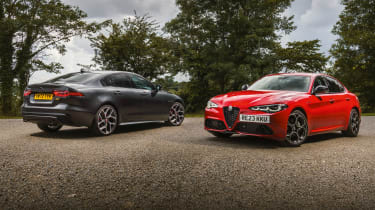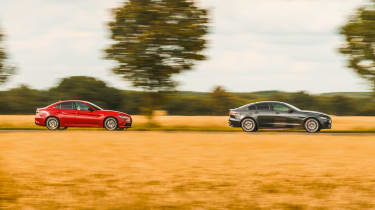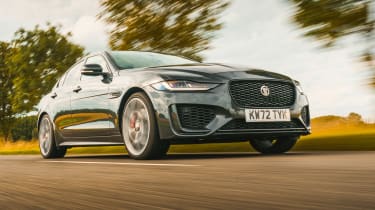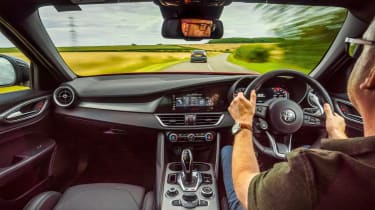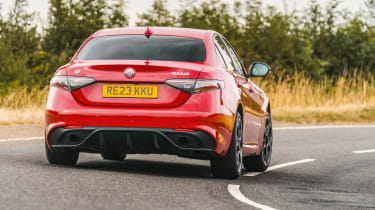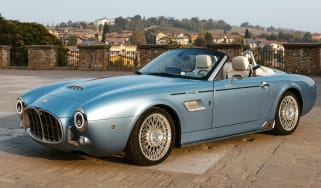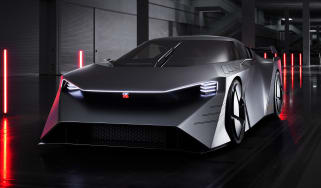Jaguar XE P300 Sport v Alfa Romeo Giulia Veloce
With Audi, BMW and Mercedes losing their lustre in the compact sports saloon market, Alfa and Jaguar are vying for top honours. We pit Giulia Veloce against XE P300
I know what you’re thinking: where’s the 3-series? The car BMW built to create and define the compact sports saloon sector. The benchmark in terms of driving dynamics, quality and, of course, sales. The 3-series is a phenomenon. Or rather it was. Its star hasn’t faded as such, rather its position has been challenged, and not by the usual suspects. Audi Sport and Mercedes-AMG may square up to the M3, but further down the pecking order an A4 or C-class in non-performance dress-up have struggled to impress, their go falling short of matching their show. Not so the offerings of Alfa Romeo and Jaguar.
The XE isn’t long for this world and production is a little on/off depending on parts supply and where JLR needs those all-important chips to be installed (Range Rovers normally, because they generate more profit than a PPE supplier back in 2020). Yet it’s a car that, since its debut in 2015, has demonstrated that the people of Bavaria aren’t the only ones who know how to make a compact sports saloon. Twelve months after the Brits did it, Italy also proved it could take on the 3-series, although this time both at grass roots level with four-cylinder models and on the main stage with the Quadrifoglio (Jaguar left the fireworks to the limited-run Project 8, another gem but one that was only short-lived and frighteningly expensive).
> BMW M340i xDrive saloon review
You will have spotted that neither car featured here is a V8-engined DTM refugee or a cut-down Ferrari-engined saloon; instead they represent a more accessible entry point to both models. In the case of the Jaguar this still means the range-topper: an XE P300 Sport AWD that will empty your current account to the tune of £43,500 before options (of which this example, one we’ve been running for the last three months and will report on in Fast Fleet soon, comes with nearly seven thousand pounds’ worth). It makes the Giulia 280 Veloce look initially expensive at £47,759, but the Alfa wants for nothing, its Milanese serpent more than a match for Coventry’s leaper in terms of on-paper spec.

Ian Callum’s XE design has aged beautifully, as tends to be the case with all Callum designs, oozing confidence, class and, perhaps more importantly in today’s world, a premium air that Audi, BMW and Mercedes spend millions trying to achieve yet continually fall short of. It’s a theme that’s carried over to the inside, too. Ergonomically, the XE feels designed for the driver – pedals, steering wheel and seat all adjust to where you want them. The layout ahead is clean and logical to use and read, the material fit and finish tight as a drum-skin.
The Jaguar’s four-cylinder Ingenium engine doesn’t have the soundtrack to match the other first impressions. There’s a gruffness from idle to high revs that leaves a blemish on the otherwise fine sheen of everything the XE has delivered so far. Yet there is an energy to the 296bhp motor that brings enough of the XE to life to encourage you to settle in and enjoy its dynamic jewels.
It starts with the ride; where else with a Jaguar? Pliant, quiet and soothing, as with all cars signed off by the now-retired Mike Cross, what you feel back through the steering and your backside is only ever everything you need to feel. The dampers read the road with such detail you have to remind yourself this is a car designed to appeal to fleet buyers and consumers who don’t want to conform to the status quo. Then there’s the way it steers – with a directness and fluidity you’d be impressed by in sports car, never mind a compact four-door saloon.
Four-wheel drive it may be, but the electronic system sends 90 per cent of the engine’s torque to the rear axle until it’s needed up front, which is rarely at all if it’s dry. You can pitch the XE in at a serious pace, the front Pirellis biting first time and the nose leading the car through the middle of the corner as you feed in more throttle as early as you feel comfortable with. Not having a particularly spikey power delivery, you find yourself driving harder with each mile, pushing the Jaguar’s chassis with every turn. And when you do start to breach its limits there’s a level of adjustability you can access through the throttle and steering that makes any transition smooth and cleanly telegraphed.
Surefooted and confidence-inspiring, the XE rewards across the tarmac to an unexpectedly high level, which brings you back to wishing it had more grunt to allow you to play and exploit it that much more. It’s a car that feels overdeveloped for the task it was designed to do.
Step into the Alfa, after you’ve pondered how a car designed to be mainstream and built in considerable volumes can look so alluring, and within a couple of hundred metres you feel the immediate benefit of Alfa Romeo’s decision to develop the Giulia around the Quadrifoglio’s needs and requirements and allow the lesser models to benefit from the expertise of the team who also created the 458 Speciale.
It too has great ergonomics, but its seats hold you more firmly, pinching your hips and securing your shoulders, plugging you into the car where the XE feels like you’re sitting on it when you jump between the two. There’s more of a tune from its 2-litre turbocharged four, too, more depth to a soundtrack that’s more inviting and enticing. Like the XE, it has an eight-speed auto and no manual option; here it’s driving the rear wheels only – through a mechanical limited-slip diff – but it wants for nothing when you push on.
Even through the first handful of corners, the Giulia highlights what’s lacking in the XE and it’s that sense of agility. Where the XE feels locked down and corners with a feeling of solidity, the Alfa provides more movement and lets you play a larger part in the process. Its quicker steering feels intuitive and natural, the car pivoting around your hip point as you pour it into a corner, the front end, like the Jaguar’s, resisting push unless you become heavy-handed and ask too much. And where you think the XE’s AWD chassis allows an impressive level of adjustability, the lighter – to the tune of 222kg – Giulia is even more responsive to you trimming your line with throttle and steering.
Neither has the power to drive out of corners with armfuls of corrective lock – unless you have a total disregard for your liberty – but they will dance across the surface to a decent tune that makes you always want to push and enjoy their talents rather than sit back and wish you had bought a car with massaging seats.
Yet it’s the Alfa Romeo that hooks you in more. It feels better balanced and more organic in its movements. Its shift paddles’ action and size inspire you to engage with them far more compared with the XE’s switch-like buttons, while the Italian’s 276bhp engine responds more keenly, even if power fades much sooner once it’s delivered its peak compared with the British-built powerplant.
Only the Alfa’s brakes remain a point of contention. In the XE, 355mm and 325mm front and rear discs are matched to a caliper and pedal set-up that is consistent in terms of feel and retardation; even when the discs heat up beyond their ideal operating temperature you can modulate accordingly. In the Giulia there is, as there always has been with current Alfas, a period of pedal travel that makes you question if they’re going to do what you have asked. Modulating the slowing process requires more thought processing than it should, and while time and experience have you adjusting your approach, it will be too big a change for some, so our advice is try before you buy.
On the subject of buying, which one should you? The Jaguar is hugely impressive, and underrated to an even greater degree. It feels more of a 3-series than the equivalent-engined model that BMW sells today, blending quality with character that Munich’s finest was once the master of.
But its engine lacks the spirit and its chassis the ultimate agility of the Alfa: the fiercely independent Italian that’s not trying to be anything but its own take on the sports saloon recipe, delivering every flavour and sensation you want from such a car. Which is why it wins by a narrow but well-earned margin here.
| Jaguar XE P300 Sport AWD | Alfa Romeo Giulia Veloce | |
| Engine | In-line 4-cyl, 1998cc, turbocharged | In-line 4-cyl, 1995cc, turbocharged |
| Power | 296bhp @ 5500rpm | 276bhp @ 5200rpm |
| Torque | 295lb ft @ 1500-4500rpm | 295lb ft @ 2250-4500rpm |
| Weight | 1651kg (182bhp/ton) | 1429kg (196bhp/ton) |
| 0-62mph | 5.9sec | 5.7sec |
| Top speed | 155mph | 149mph |
| Basic price | £43,500 | £47,759 |
This story was first featured in evo issue 313.

